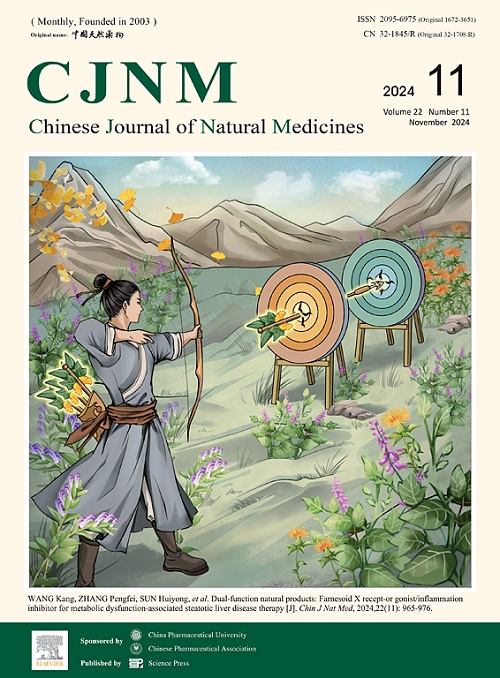Azaphilone derivatives with RANKL-induced osteoclastogenesis inhibition from the mangrove endophytic fungus Diaporthe sp.
IF 4.9
2区 医学
Q1 INTEGRATIVE & COMPLEMENTARY MEDICINE
引用次数: 0
Abstract
This study identified six novel azaphilones, isochromophilones G−L (1−6), and three novel biosynthetically related congeners (7−9) from Diaporthe sp. SCSIO 41011. The structures and absolute configurations were elucidated through comprehensive spectroscopic analyses combined with experimental and calculated electronic circular dichroism (ECD) spectra. Significantly, three highly oxygenated azaphilones contain an acetyl group at the terminal chain (4) or linear conjugated polyenoid moieties (5 and 6), which occur infrequently in the azaphilone family. Additionally, several compounds demonstrated inhibition of lipopolysaccharide (LPS)-induced nuclear factor kappa-B (NF-κB) activation in RAW 264.7 macrophages at 20 μmol·L−1. The novel compound (1) effectively inhibited receptor activator of NF-κB ligand (RANKL)-induced osteoclast differentiation without exhibiting cytotoxicity in bone marrow and RAW 264.7 macrophages, indicating its potential as a promising lead compound for osteolytic disease treatment. This research presents the first documented evidence of azaphilone derivatives as inhibitors of RANKL-induced osteoclastogenesis.
红树林内生真菌Diaporthe sp.中具有rankl诱导破骨细胞生成抑制作用的氮蚜酮衍生物。
本研究从Diaporthe sp. SCSIO 41011中鉴定出6个新的氮化氮素,G−L(1−6)和3个新的生物合成相关同源物(7−9)。通过综合光谱分析,结合实验和计算的电子圆二色性(ECD)光谱,阐明了其结构和绝对构型。值得注意的是,三种高度氧化的氮唑啉类化合物在末端链(4)或线性共轭多烯基团(5和6)上含有乙酰基,这在氮唑啉类化合物家族中并不常见。此外,几种化合物在20 μmol·L−1时抑制脂多糖(LPS)诱导的RAW 264.7巨噬细胞核因子κ b (NF-κB)的激活。新化合物(1)有效抑制NF-κB配体受体激活剂(RANKL)诱导的破骨细胞分化,而在骨髓和RAW 264.7巨噬细胞中不表现细胞毒性,表明其有潜力成为治疗溶骨性疾病的有希望的先导化合物。本研究首次提出了azaphilone衍生物作为rankl诱导的破骨细胞发生抑制剂的文献证据。
本文章由计算机程序翻译,如有差异,请以英文原文为准。
求助全文
约1分钟内获得全文
求助全文
来源期刊

Chinese Journal of Natural Medicines
INTEGRATIVE & COMPLEMENTARY MEDICINE-PHARMACOLOGY & PHARMACY
CiteScore
7.50
自引率
4.30%
发文量
2235
期刊介绍:
The Chinese Journal of Natural Medicines (CJNM), founded and sponsored in May 2003 by China Pharmaceutical University and the Chinese Pharmaceutical Association, is devoted to communication among pharmaceutical and medical scientists interested in the advancement of Traditional Chinese Medicines (TCM). CJNM publishes articles relating to a broad spectrum of bioactive natural products, leading compounds and medicines derived from Traditional Chinese Medicines (TCM).
Topics covered by the journal are: Resources of Traditional Chinese Medicines; Interaction and complexity of prescription; Natural Products Chemistry (including structure modification, semi-and total synthesis, bio-transformation); Pharmacology of natural products and prescription (including pharmacokinetics and toxicology); Pharmaceutics and Analytical Methods of natural products.
 求助内容:
求助内容: 应助结果提醒方式:
应助结果提醒方式:


